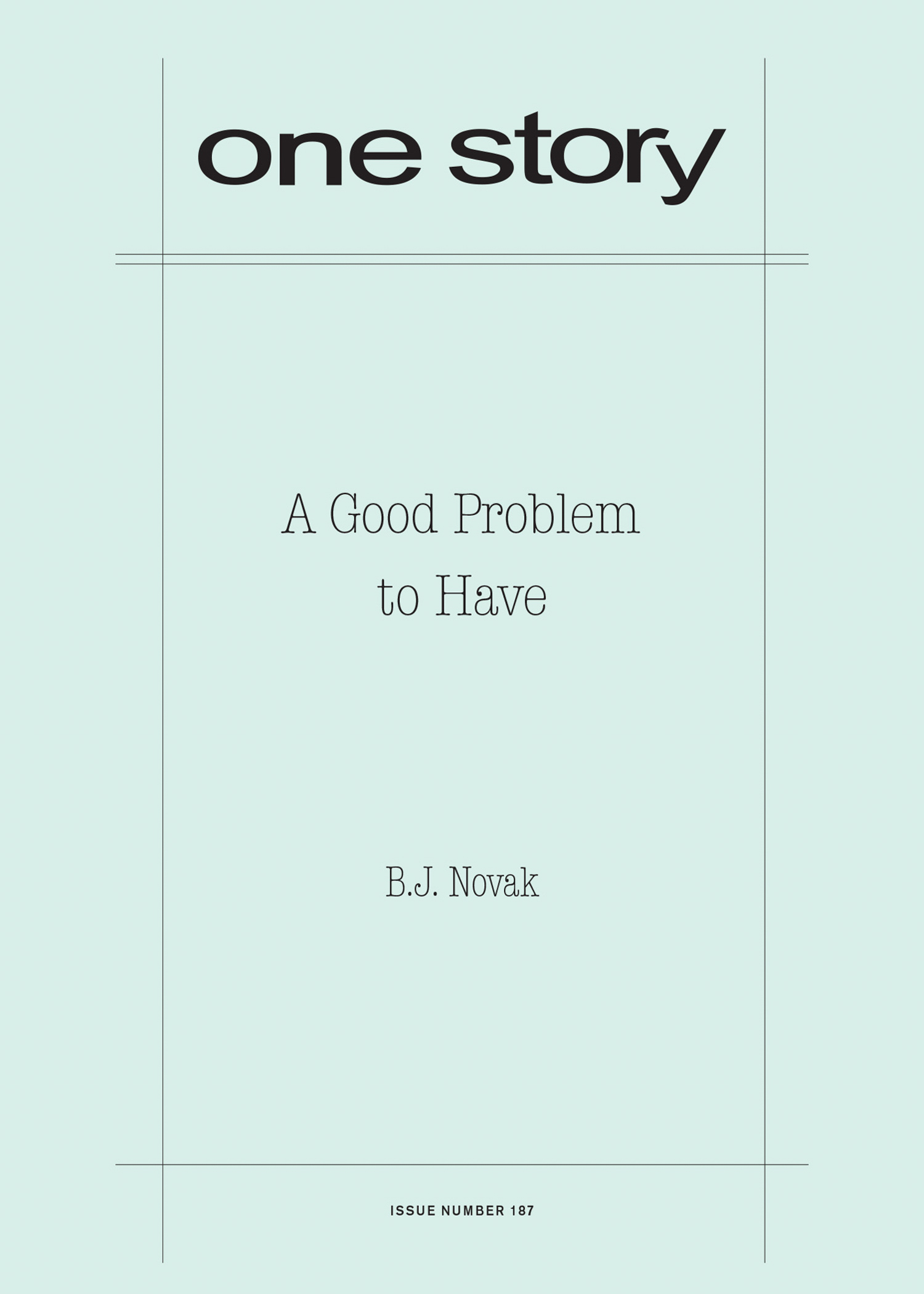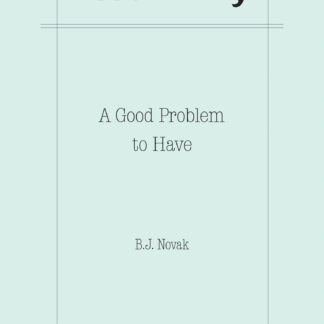
A Good Problem to Have
$2.50
18 in stock
Excerpt
When we were in the fourth grade, an old man burst into our classroom one day waving his rumpled little plaid arms and screaming. It might have been adorable if we had been old enough to find older people adorable, and also if it hadn’t been a little bit scary.
“Stop! Is he saying anything about trains? About train times? Stop!”
Our teacher, Mr. Hunt, had a mustache and an inner calmness about him, and we never noticed that then he must have only been in his twenties. He put his arm lightly across the old man’s back and led him to a big wooden chair in the corner of our class, a chair that none of us ever actually sat in but that might look to a visitor like a seat of honor.
“How can we help you?” asked Mr. Hunt.
“Are you asking them questions about trains?” asked the old man.
“No,” said Mr. Hunt. “We’re talking about geometry today. Can I help you with something? Would you like a glass of water?”
Mr. Hunt had an accent that my parents identified as a working-class one from Dorchester, Massachusetts. Some of us thought it made him sound cool, and some of us thought it made him sound like an old lady. Either one may have been why the old man seemed to calm down a little bit whenever Mr. Hunt spoke.
B.J. Novak
B.J. Novak is a writer and actor best known for his work on NBC’s Emmy Award-winning comedy series The Office as an actor, writer, director, and executive producer. He is also recognized for his stand-up comedy performances and his roles in motion pictures such as Quentin Tarantino’s Inglourious Basterds and Disney’s Saving Mr. Banks. He is a graduate of Harvard University with a degree in English and Spanish literature. One More Thing: Stories and Other Stories is his first collection and will be published by Knopf in February 2014.
Will Allison on “A Good Problem to Have”
A man leaves Chicago on a train heading for Cleveland at 60 miles per hour. Another man leaves Cleveland heading for Chicago on a train going 85 miles per hour. How long before the two trains cross paths? This standard math question is something we all eventually face in grade school. To solve it, determine the distance (308 miles), the relative rate of the two trains (60 + 85=145), and use the formula Distance ÷ Rate = Time. But what if some of the elements of this equation changed? What if the two people traveling weren’t strangers, but a man and woman who are in love? What if the distance wasn’t 308 miles, but the years since one of them has passed away? What if the child solving this problem learns not math—but how to live a fuller life? All of these questions come into play in our new issue, B.J. Novak’s “A Good Problem to Have.” This short piece begins as a mad-cap lark, when the aged author of our famous train problem arrives and demands compensation from a fourth grade class. But as he settles in and tells his tale, the students soon learn that the truth behind this equation isn’t arithmetic—it’s a love story and life lesson hidden within the numbers. Be sure to read Contributing Editor Will Allison’s Q&A with B.J. Novak about the inspiration behind this sharply written, funny, curious, and moving story. In the meantime, take out a piece of scrap paper and start crunching those numbers. (The answer is: two hours and twelve minutes. The other answer is: make every second count.)
Q&A by Will Allison
- WA: Where did the idea for this story come from?
- BN: I was reading a Michel Houellebecq interview in which he was talking about intellectual property rights, and he made a quick passing reference to—among other examples—the hypothetical publishing rights of an author of a classic textbook problem. That caught my imagination: who did write those problems? And what if one of them did indeed seek compensation?
- WA: What was the most challenging aspect of writing this story?
- BN: Figuring out how to justify the first-person viewpoint. The real story is that of the old man who bursts into the classroom, but I felt like telling it first-person from the perspective of someone who saw it happen. So: who was this person, and how could I make this person just interesting enough to justify his role as the narrator, without distracting from the main story I wanted to tell? I rewrote it in third-person, then wrote it in first-person again, making changes each time.
- WA: How did you come to fiction writing?
- BN: I’ve written a fair amount of fiction before, if you count things in script form—mainly scripts for The Office—and writing those scripts, I often wished I had an excuse to go a little longer with some of the stage directions. After my time on The Office ended, I went through the years’ worth of pocket notebooks I had kept and transcribed them. I had a fantasy that I only later realized was ridiculous that somehow, out of these dozens of notebooks of stray ideas, I would be able to cobble together a screenplay or two. After a couple of months of trying to decide where to start, I got into the idea of trying to serve each idea in prose form—whether an idea was worth a few lines or a number of pages, I’d just try to do right by each one. And then once I started thinking in that way, every idea I had translated itself into a potential story in my mind.
- WA: Given the chance to pigeonhole yourself, would you say you’re more a writer, an actor, a director, a stand-up comedian, an executive producer, or none of the above?
- BN: “Writer” is what I put on customs forms when I visit another country. To me, producing and directing and performing feel like extensions of writing—it just means I’ve been given the ability to show exactly what I think is meant by my (or occasionally someone else’s) writing. But perhaps a born “actor” or “producer” would see writing a script simply as a means of controlling his own performance. That said, acting is a little different, a little special. For everyone, I think. Everyone likes to perform. Even Shakespeare couldn’t resist acting when he had the chance, and I bet a lot of his friends told him he should focus more on his writing.
- WA: Your forthcoming debut collection, One More Thing: Stories and Other Stories, comprises sixty-four pieces of fiction ranging in length from three lines to twenty-two pages. How do you know how long a piece should be?
- BN: The revelation that I could write each piece exactly as long as I wanted it to be, and embrace a book of jagged lengths and ambitions, was the key breakthrough that made me devote so much time and effort to prose fiction, all of a sudden. I had never put my finger on just how intimidated and discouraged I had gotten over the idea of writing prose by the notion that a New Yorker comedy piece had to be a certain length, and a short story had to be a certain length. It was major for me to give myself permission to ignore all that. In terms of knowing when a story is over, I think every writer (or musician, or artist, etc., probably) just kind of knows when he has said all he wanted to say about whatever inspiration he was trying to serve. That said, sometimes my editor, Tim O’Connell, would make a note in a draft that he’d like to see more about a particular direction or character or tangent, and I’d think, hmm, sure, what about that? And then I’d play around with that and see if there was anything else there.
- WA: The pieces in the collection were developed through a series of public readings in front of live audiences. Can you talk about any differences you observed between what works in a live reading versus what works on the page?
- BN: The main takeaway is how similar they are. What works on the page and what works read aloud have an incredibly strong overlap—enough so that I believe you could essentially use it as your only compass and get along just fine. There are a few exceptions, sure—stories with more diverse and playful voices, more comedy, and more mystery work a little better onstage, and stories with stronger emotional payoffs later in the narrative work better on the page—but it’s much more of a revelation to pay attention to the rule than to the exceptions, in my opinion.
- WA: I found many of the pieces in the collection very funny (including this one), but I also found many of them quite tender and moving (including this one). Can you talk about the balance between humor and pathos in your work?
- BN: Thanks for saying that. One of the most important lessons I learned working on The Office was about how there is a certain zone where honesty and comedy feel almost indistinguishable, to the point where either can be used as a compass for the other. At its best, writing for and acting on The Office, that’s what it felt like: if you were really honest, you could trust it was probably funny; and if something felt really funny, you could trust that it was funny because it was honest. That’s the area I almost always aspire to be in.
- WA: A man leaves Chicago at twelve p.m. on a train heading for Cleveland at sixty miles per hour. Another man leaves Cleveland at one p.m. heading for Chicago on a train going eighty-five miles per hour. How long did it take you to complete this story?
- BN: Probably a dedicated week or two, spread out over a distracted month or two.
- WA: What are you working on now?
- BN: A children’s book called The Book with No Pictures.
- WA: You’ve stated that the one piece of writing advice you’ve ever felt qualified to give is: write for the kid sitting next to you. All qualifications aside, what is the best bit of writing advice you’ve ever received?
- BN: There was a banner that hung across my third grade classroom: “That Which Is Written Without Effort Will Be Read Without Pleasure.” I have no idea what that sign was doing in a third grade public school classroom, but it haunted me. I never wanted to write anything that was read without pleasure. I still think about that sign all the time.
